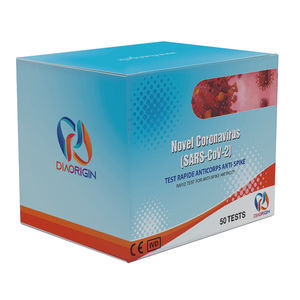
- Laboratory
- Laboratory medicine
- COVID-19 rapid test
- Diaorigin Biotechnology
COVID-19 rapid test DO-06Mfor neutralizing antibodybloodcassette
Add to favorites
Compare this product
Characteristics
- Applications
- COVID-19
- Tested parameter
- for neutralizing antibody
- Sample type
- blood
- Format
- cassette
- Result display time
15 min
Description
SARS-CoV-2 NEUTRALIZING ANTIBODIES,
WHAT IS IT ABOUT ?
When one is vaccinated or infected with the virus, the immune system produces antibodies. Most of the antibodies produced are binding antibody, which bind specifically to the virus, but do not reduce its infectivity. Only a small part are neutralizing antibodies , which block the entry of the virus into the target cells and destroy it.
Our test method is based on fluorescence quenching immunochromatography. The nitrocellulose membrane is fluorescently labeled. The ACE2 protein is immobilized on the T line (Test), and the anti-IgY antibody is immobilized on the C line (Control). The Spike protein (RBD domain) of SARS-CoV-2 and the IgY are dried on the migration zone. Once the sample to be tested has been added, the anti-RBD antibodies will combine with the RBD protein and migrate to the T line, where they encounter ACE2. Remember that only neutralizing antibodies are capable of cutting the RBD/ACE2 bond. If the antibodies combined with RBD are neutralizing, they do not bind with ACE2, so the T line will appear fluorescent. On the other hand, if the antibodies are not neutralizing, the RBD will hang with ACE2 and reduce or even extinguish the fluorescence of the T line. The fluorescence on the C line is completely extinguished by the IgY which hang on the C line (anti-IgY). By measuring the fluorescence on the T line and on the C line, the inhibition of neutralizing antibodies can be calculated as follows:
% Inhibition = (T fluorescence - C fluorescence)/baseline fluorescence * 100
Related Searches
- Blood rapid diagnostic test
- Rapid lateral flow test
- Immunoassay rapid diagnostic test
- Cassette rapid diagnostic test
- Rapid virus test
- Rapid respiratory infection test
- COVID-19 rapid diagnostic test
- Strip rapid diagnostic test
- Clinical rapid diagnostic test
- Rapid test with digital reader
- Fluorescence rapid diagnostic test
- Neutralizing antibody rapid test
*Prices are pre-tax. They exclude delivery charges and customs duties and do not include additional charges for installation or activation options. Prices are indicative only and may vary by country, with changes to the cost of raw materials and exchange rates.


